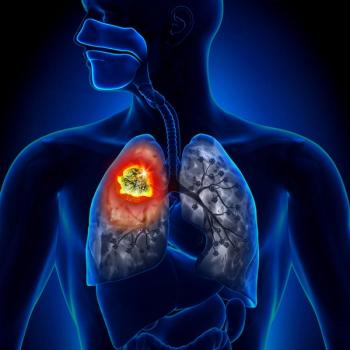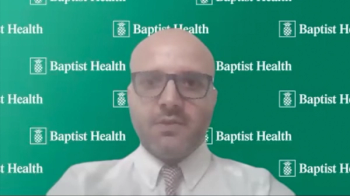
Blood Test Shows Promise for Detection of Cancer
Results from a blood-based multi-cancer detection test potentially indicated the presence of cancer.
A blood-based multi-cancer early detection (MCED) test indicated potential cancers in 1.4% of individuals from an otherwise healthy cohort of 6621 participants aged 50 years or older. These positive signals led to a cancer diagnosis in 35 individuals using standard diagnostic tools, according to findings from the prospective PATHFINDER study (NCT04241796) presented at the
Based on these findings, the specificity of the test was determined to be 99.1%, with a positive predictive value of 38.0% (95% CI, 28.8%-48.3%). In most cases (97.1%) the test was able to indicate where the tumor was located, which helped to guide diagnostic procedures (95% CI, 85.1%-99.8%). Overall, there were 19 solid tumors and 17 hematologic cancers diagnosed, many of which do not currently have standard screening tests available, according to lead investigator Deb Schrag, MD, MPH.
“The exciting thing about this approach is that it detected solid tumors and liquid tumors. It's really a pan-tumor assay,” Schrag, chair, Department of Medicine, Memorial Sloan Kettering Cancer Center, said when presenting the results. “MCED screening was safely implemented in adults over 50 years of age. When the blood tests were positive, workups were typically completed in less than 3 months. I think this is really a new concept. It shows it is feasible to detect cancers using blood tests."
The test utilizes both next-generation sequencing and machine learning algorithms to analyze methylation patterns in cell-free DNA from whole blood specimens. The MCED test results indicate whether a cancer signal is detected and, if positive, the test provides a suspected tissue of origin, based on the type of methyl group identified.
In the PATHFINDER study, blood collection and ordering of the test was added to standard cancer screening. Test results were returned to the investigators to discuss with the participant. There were 2 cohorts of patients. Cohort A included those at elevated risk of cancer, defined as a previous history of cancer more than 3 years prior to the study, history of smoking >100 cigarettes in their lifetime, or a genetic cancer predisposition or hereditary syndrome. Cohort B contained other patients who did not meet these criteria. Regular guideline-recommended cancer screenings were also continued.
If a test was negative, no additional steps were taken until follow up at 12 months. In the case of a positive test, the diagnostic approach selected was left to the investigator's discretion. Most patients (90.9%) with a true positive test (n = 35) received more than 1 imaging test and 81.8% underwent more than 1 invasive diagnostic procedure. In those with false-positive results (n = 57), 93.0% of patients received more than 1 imaging test and 29.8% received more than 1 invasive procedure.
The median time from a positive test to resolution was 79 days across all 92 patients. This varied between the true-positive and the false-positive group. For those in the true-positive group, a diagnosis was made in a median of 57 days compared with a median time to resolution of 162 days in those with a false-positive result.
There were 36 cancers detected in the 35 people, with 24 in the high-risk group and 11 in the non–high-risk group. Of those detected, 14 were stage I or II disease and 7 were found in individuals with a known history of cancer. Overall, there were 26 cancers identified in groups lacking a standard screening test.
The types of cancers detected were lymphoma (n = 12), breast (n = 5), colon/rectum (n = 2), prostate (n = 2), lymphoid leukemia (n = 2), Waldenström macroglobulinemia (n = 2), oropharyngeal (n = 2), liver (n = 1), intrahepatic bile ducts (n = 1), lung (n = 1), pancreas (n = 1), small intestine (n = 1), ovary (n = 1), uterus (n = 1), bone (n = 1), and plasma cell myeloma disorders (n = 1).
“We had 1 patient who had both a breast and an endometrial cancer,” Schrag said. “I think what's exciting about this new paradigm, in concept, is that many of these are cancers for which we do not have any standard screening.”
A prespecified retrospective analysis was conducted using an updated version of the MCED test, known as Galleri, on banked blood samples from the study. With this test, a positive signal was indicated in 0.9% of patients, bringing the specificity up to 99.5%. The positive predictive value for the refined MCED test was 43.1%. The tissue of origin was detected in 88% of patients. For the refined test, 263 patients would need to be screened to identify 1 patient with cancer compared with 189 with the standard test definition.
Anxiety surrounding the screening process was collected using the Patient Reported Outcomes Measurement Information System (PROMIS).2 The baseline anxiety score across patients was approximately 47. In those with a positive signal detected, there was a mean 3.6-point increase in anxiety levels when the results were returned, compared with an increase of only 0.7 for those with a negative signal. At the time of diagnostic resolution, there was a 2.5-point increase over baseline in anxiety. By the end of the study, however, anxiety levels returned to similar levels as baseline.
Overall, 5749 patients completed a satisfaction survey, with most (~97%) indicating some level of satisfaction with the test. Overall, 48.5% were extremely satisfied, 33.3% were very satisfied, and 15.3% were satisfied.
“This study was a prelude to a larger study. We needed to see how physicians would approach workup, what diagnostic odysseys we'd send patients down, and whether they'd be upset,” said Schrag. “People were a little anxious, but it was manageable, and it was transient. People understood the ramifications of this test and they were a little anxious, but they managed very well.”
In July, GRAIL, the developer of the Galleri test, announced it had completed enrollment in a large randomized, controlled study to further examine the refined MCED test.3 The trial, which is being conducted in collaboration with the National Health Service England, enrolled 140,000 healthy individuals aged 50 to 77 years. In this study, the test will be used at baseline and then annually for 2 additional years. Patients were randomized 1:1 to the MCED test or control. Results are expected in 2026 (ISRCTN91431511).
References
- Schrag D, McDonnell III CH, Nadauld L, et al. A prospective study of a multi-cancer early detection blood test. Ann Oncol. 2022;33(suppl 7).DOI:10.1016/j.annonc.2022.07.1029.
- Schrag D, Beer TM, McDonnell III CH, et al. Evaluation of anxiety, distress and satisfaction with a multi-cancer early detection test. Ann Oncol. 2022;33(suppl 7).DOI:10.1016/j.annonc.2022.07.1034.
- GRAIL News Release. Grail and National Health Service (NHS) England Complete Enrollment of 140,000 Participants in Largest Study of Multi-Cancer Early Detection Test. Published: July 18, 2022. https://bwnews.pr/3d7WBPh. Accessed: September 11, 2022.
Newsletter
Stay up to date on recent advances in the multidisciplinary approach to cancer.



















































































